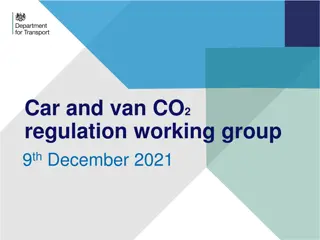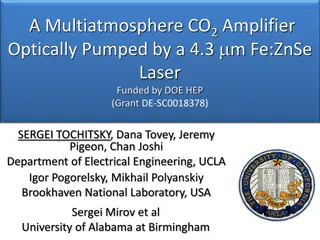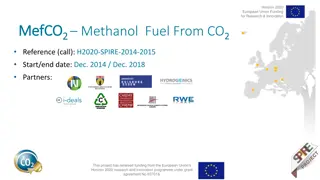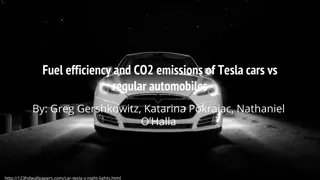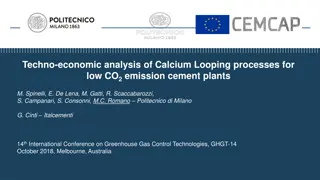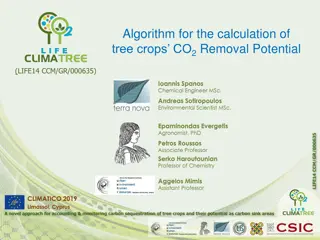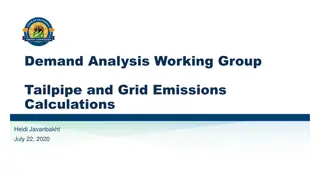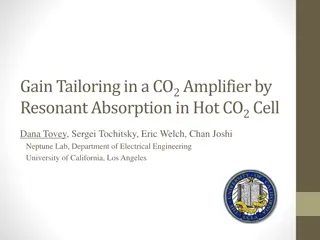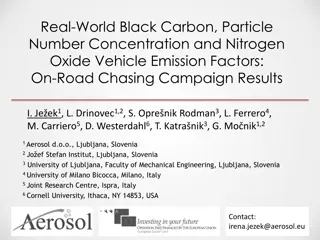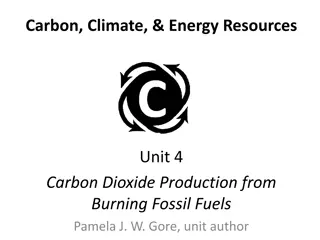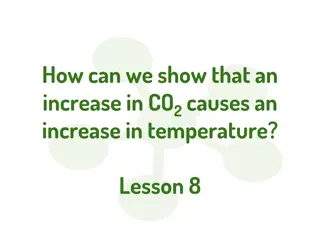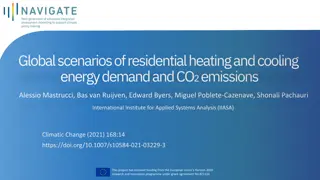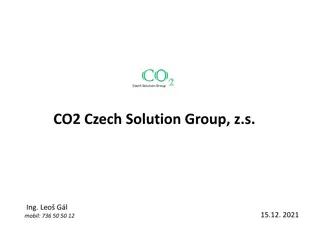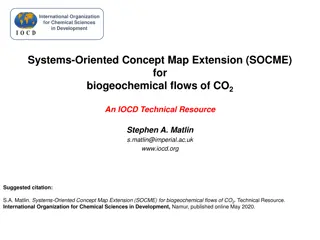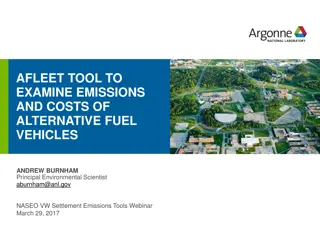Understanding Vehicle CO2 Emissions: Data Analysis Project
World Health Organization reports 4.2 million premature deaths from outdoor air pollution. This project aims to analyze factors influencing CO2 emissions from vehicles. Data collected from Kaggle is used to train and validate a linear regression model and decision tree model. Business objectives include identifying key variables affecting emissions and comparing fuel consumption impacts in city vs. highway driving.
Download Presentation

Please find below an Image/Link to download the presentation.
The content on the website is provided AS IS for your information and personal use only. It may not be sold, licensed, or shared on other websites without obtaining consent from the author. Download presentation by click this link. If you encounter any issues during the download, it is possible that the publisher has removed the file from their server.
E N D
Presentation Transcript
Predict CO2 Emissions Group 3 Karla Valcarcel Marinez Stefanie Brown Swati Mahajan
According to the World Health Organization (WHO), outdoor air pollution has led to approximately 4.2 million premature deaths ( Ambient (Outdoor) Air Pollution ). Additionally, air pollution has led to ocean acidification, which causes ocean temperatures to rise and creates irreversible damages to marine ecosystems. Finally, air pollution leads to food insecurity due to changes in temperature and precipitation affecting crop yields (Ziska et al.) and shifting agricultural zones. Business Problem
Business Objectives The primary objective for this project is to discover and understand how CO2 emissions from a vehicle can vary based on different characteristics of that vehicle such as its model, transmission, fuel type and fuel consumption. By understanding what factors increase CO2 emissions, car manufacturers can improve their impact on global warming by reducing the carbon footprint for the vehicles they produce.
Addressing Business Objectives Addressing Business Objectives What is the influence of different variables in a vehicle on its CO2 emission levels? What is the most influencing factor on CO2 emissions? In terms of data analysis, is there a significant difference in the CO2 emissions for fuel consumption by vehicles driven in a city and fuel consumption by vehicles driven on a highway?
Data Data We collected the data from Kaggle website. There were 7,385 observations in the dataset. There were no missing values in the dataset. Target Continuous variable CO2Emissions Independent variables Make, model, Vehicle Class, Engine Size, Cylinders, Transmission, Fuel Type and four Fuel Consumption variables for city, highway, combined in liters and combined in mpg. We split the dataset into 75% training dataset and 25% validation dataset.
Decision Tree Model Decision Tree Model
Principal Component Analysis Principal Component Analysis (PCA) (PCA)
Linear Regression using PCA Linear Regression using PCA The model statistics are shown here.
Linear Regression - Very easy to implement. Provided high R2 of 0.89 and RMSE of 18.79. CO2 can be easily estimated by plugging the variables into the equation generated: 314 6.4Compact + 21Large 9Medium 0.6Small + 7.1EngineSize + 8.7Cylinder 0.5Gear 4.6FuelMPG Decision Tree - Easy to implement using JMP software. It resulted in139 splits for our dataset, which made it difficult to interpret and capture. It provided the best R2 of 0.978 on training and 0.969 on validation and provided the least RASE of 8.7 for training dataset and 10.2 for validation dataset. Model Comparison Principal Component - Easy to implement using JMP software. Reduced the input variables to only two principal Components, though it is difficult to find any direct relationship between the actual variables and Principal Components. Provided R2 of 0.89 And RMSE of 19.29
Results Both Linear Regression models provide similar R2 of 0.89 and RMSE of about 19. However, the Decision Tree model provides better results in terms of R2 of 0.97 and RASE between 8 to 10. It is difficult to interpret the large decision tree with 139 splits and draw any direct conclusion. For a dataset like ours, we would prefer a Linear Regression model which is easy to interpret, and we can draw important conclusions and recommendations based on the model equation: CO2Emission = 314 6.4Compact + 21Large 9Medium 0.6Small + 7.1EngineSize + 8.7Cylinder 0.5Gear 4.6FuelMPG Our analysis helped us find that smaller vehicles and vehicles with smaller transmission tended to release less Co2 into the environment
Recommendations Large cars like cargo vans, large passenger cars and trucks have highest CO2 emissions. Users should prefer compact, small and medium size cars/SUVs. Engine size and number of cylinders in a car have an impact on the CO2 emissions as well. To lower the CO2 emissions, one should prefer a car with smaller engine size and lower number of cylinders. Cars with high miles per gallon (MPG) should be preferred over the ones provides lower mpg to reduce the CO2 emissions


